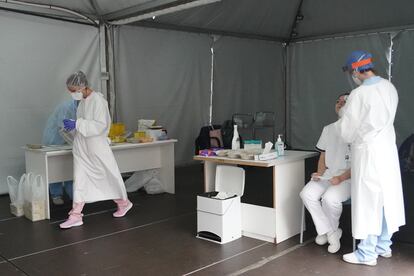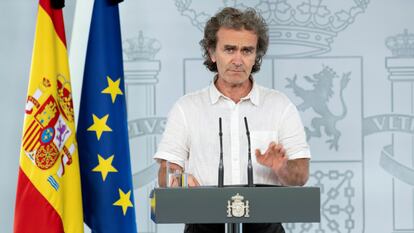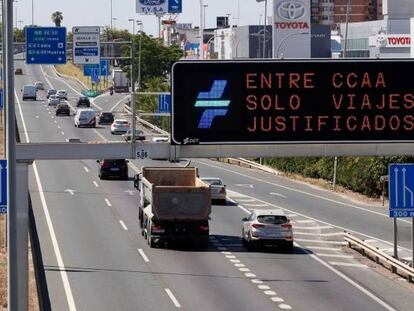75% of new coronavirus cases reported in Madrid and Catalonia
According to the latest data, 84 infections were detected on Tuesday, nearly double the figure from the day before


The Spanish Health Ministry reported on Tuesday that 84 new coronavirus cases had been registered in the previous 24 hours. This is nearly double Monday’s figure of 48, which was the lowest seen since March 5. Three fourths (75%) of the new infections on Tuesday were detected in two regions: Madrid and Catalonia.
The fact that the number of new diagnoses has nearly doubled is not overly significant given that an uptick is usually expected on Tuesday due to underreporting over the weekend. But the latest figures do show that Madrid is the region with the highest number of new coronavirus cases. Indeed on Monday, Madrid reported 45 of the 48 new diagnoses in all of Spain. Meanwhile, the regions of Murcia, Basque Country, La Rioja, and the North African exclave cities of Ceuta and Melilla recorded no new cases on Tuesday.
Health officials say Spain is testing between 10,000 and 12,000 suspected Covid-19 cases every day
According to the latest figures, there were 50 coronavirus-related deaths in the last seven days. The total death toll, however, has yet to be updated and remains at 27,136 for the third day running. The Health Ministry changed how it presents the total number of victims, so that only fatalities that occurred the day before are added to the death toll. For the past 15 days, fatalities that took place at an earlier date, but were only recently reported to the Health Ministry, have not been included in the official count.
Fernando Simón, the director of the Health Ministry’s Coordination Center for Health Alerts, has said that the full total will be published once the historical series is revised and the fatalities are ordered according to the date of death, and not the date of notification.
The problems with presenting the data began on May 25, when a new system was introduced for reporting coronavirus-related deaths. The change has meant that the daily report no longer states how many fatalities have been notified in the previous 24-hour period, which could include victims who died days or weeks ago. Instead, it only reports the number of deaths that occurred in the previous seven days, in other words the most recent fatalities. According to health authorities, the date of death is more relevant than the date of notification.

Simón explained on Tuesday that the official coronavirus death toll has been “frozen” while regions revise the historical series. There are thousands of deaths that are yet to be assigned to a specific date, and that are in a kind of limbo. The ministry is due to include them in the updated data this week.
At a press conference on Tuesday, Simón said that Spain is testing between 10,000 and 12,000 suspected Covid-19 cases every day. According to the health official, PCR tests, which are considered the most reliable detector of the coronavirus, were done on 90% of these cases. Simón also praised the regions’ “great effort” in detecting new cases, arguing that this was ensuring the outbreak’s “soft downward” trend.
According to the latest figures, a total of 241,966 people have contracted the coronavirus since the beginning of the pandemic. In the last week, 2,178 new infections were detected. Of this figure, 64% were reported in Madrid and Catalonia. In the last seven days, 231 coronavirus patients began to experience symptoms.
English version by Melissa Kitson.
Tu suscripción se está usando en otro dispositivo
¿Quieres añadir otro usuario a tu suscripción?
Si continúas leyendo en este dispositivo, no se podrá leer en el otro.
FlechaTu suscripción se está usando en otro dispositivo y solo puedes acceder a EL PAÍS desde un dispositivo a la vez.
Si quieres compartir tu cuenta, cambia tu suscripción a la modalidad Premium, así podrás añadir otro usuario. Cada uno accederá con su propia cuenta de email, lo que os permitirá personalizar vuestra experiencia en EL PAÍS.
¿Tienes una suscripción de empresa? Accede aquí para contratar más cuentas.
En el caso de no saber quién está usando tu cuenta, te recomendamos cambiar tu contraseña aquí.
Si decides continuar compartiendo tu cuenta, este mensaje se mostrará en tu dispositivo y en el de la otra persona que está usando tu cuenta de forma indefinida, afectando a tu experiencia de lectura. Puedes consultar aquí los términos y condiciones de la suscripción digital.
More information
Últimas noticias
Most viewed
- Reinhard Genzel, Nobel laureate in physics: ‘One-minute videos will never give you the truth’
- Oona Chaplin: ‘I told James Cameron that I was living in a treehouse and starting a permaculture project with a friend’
- Pablo Escobar’s hippos: A serious environmental problem, 40 years on
- Why we lost the habit of sleeping in two segments and how that changed our sense of time
- Charles Dubouloz, mountaineering star, retires at 36 with a farewell tour inspired by Walter Bonatti










































